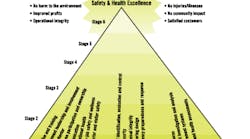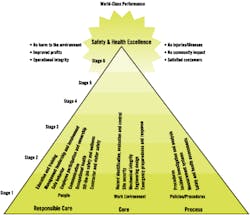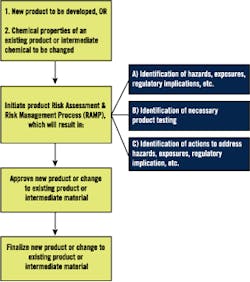Continuous improvement. A noble goal, but one that is easier said than done in any aspect of our lives.
Yet American Chemistry Council (ACC) and Synthetic Organic Chemical Manufacturers Association (SOCMA) members and partners must commit to continuous improvement in their operations through the Responsible Care initiative's six existing Codes of Management Practices. (A seventh code, the Security Code, currently is under development. See p. 15 for a related story.)
Many companies, however, have achieved remarkable success, going "over and beyond the call of duty" in code implementation. Chemical Processing invited several of these overachievers to share their stories with us.
Connecting with communities
Of all the Codes of Management Practices, the Community Awareness and Emergency Response (CAER) Code is perhaps the most visible, requiring chemical facilities to ensure emergency preparedness and to foster right-to-know through an openness and dialogue with their local communities. Standouts in this area have a particularly strong commitment to their communities ," often facilitated through their community advisory panels (CAPs).
Norwalk, Conn.-based Arch Chemicals Inc. enjoys an exceptionally healthy relationship with its nine CAPs. According to Laura Tew, Arch's director of stakeholder relations, CAP members are vital to the company's CAER Code implementation.
In fact, when Arch went through its management systems verification (MSV) last year at its Shreveport, La., and Brandenburg, Ky., facilities, the CAPs played an important role in the process. Selected CAP members not only helped prepare for the MSV process, says Tew, but also joined the peer reviewers in interviewing executives at company headquarters and plant-level management and operating personnel at the two facilities.
"It was particularly helpful to us in bringing that third-party view to our MSV," contends Tew. "We felt it made it more meaningful and more helpful to us." The company posted the executive summary associated with these efforts on its Web site, she adds, to share the experience with all of its business locations.
Arch views its CAPs as a benefit to both the communities and company operations, not as an obligation. For example, its Rochester, N.Y., facility and associated CAP have had a "wonderful sustaining" relationship for more than 10 years, says Tew. The Arch facility has an elementary school initiative in place that has enriched both students and teachers, and the principal has dedicated a significant amount of time to serving on the CAP.
To the company's benefit, the same CAP has been "consistently involved" in a groundwater contamination issue at the facility site, says Tew. "Not only are they able to give us insight from a public point of view by talking with project managers, but they also are in evidence and support at public meetings with the New York State Department of Environmental Conservation," she notes. "They've been able to ask probing questions and give us the public view on this project for many years."
Arch also believes in measuring the results of its CAER Code efforts, says Tew, and calls on its CAP members to evaluate themselves in five key areas of success. At least every two years, CAP members grade themselves ," using a numerical ranking system ," in five categories: organizational structure, member participation, representation of the community's diversity, information sharing and community outreach. Developed by the CAPs, the tool helps identify where improvements are needed.
CAP members also evaluate Arch's CAP-related efforts through surveys that are mailed out every other year. "By looking over [the results], we can see how Arch needs to improve," stresses Tew.
Through its involvement with its CAPs, Arch has been able to improve the public's perception of its operations, adds Tew. "I think in the beginning, with every CAP, there's a bit of a suspicion," she says. "Over time, that role becomes better understood just through the process of exchange and working on projects together."
The Lonza Group Riverside facility in Conshohocken, Pa., boasts exceptional performance in both community awareness and emergency response.
Paul Sieracki, the facility's operations manager, credits the Switzerland-based Lonza Group and its commitment to the overall Responsible Care initiative to the site's stellar achievements under the CAER Code. The Lonza Group purchased the site in 1992 from SmithKlineBeecham and used the Responsible Care program "as sort of an initiative to get involved with the community," he explains.
"The first thing we did was conduct a survey, basically trying to find out if people knew who we were and what we did," says Sieracki. "We pretty much found out that they didn't know who we were or what we did. So we did a mass mailing. We contacted several leaders in the community. We sent them some information about the company, and then we invited them in."
Since that earlier introduction, the Riverside site started a CAP and has become a very enthusiastic participant within the community. "We sponsor lots of teams in different organizations," notes Sieracki. "We have one of our employees on the citizens' advisory council to the police department as a chairman of that group. There's a community day every year that we participate in ," we set up a big table and hand out information and answer questions. We have a science shadowing program where every year we bring in high schools students who spend a day here going through our labs to get an idea of what chemistry is all about."
The company also is involved in senior citizen activities, fire company tours, HAZMAT drills, the Lonza Emergency Response Team (LERT) Fire School training and more. "It's one of our core values ," getting involved with the community," adds Sieracki.
And that involvement is paying off: A subsequent Lonza survey showed that the community knew who the company was and what it did. "We have a really good relationship with the township officials and the leaders," Sieracki stresses. "Anytime they need something or some support or some involvement, they contact us."
Based on the facility's strong relationships with the community and police department, the plant was selected by the county to host a drill last year that recreated and managed an emergency situation.
"We usually have at least one drill per year with our local township," explains Sieracki, "and there are a couple of local fire companies that are involved. Because we have a site that can accommodate that and we are interested in practicing, the township contacted the county when the county was looking to test their communications systems."
The large-scale drill involved a number of different witnesses, says Sieracki. "We had different townships here; we had Montgomery County officials; we had EPA and also the Pennsylvania Emergency Management Agency," he says. "[The drill] was mostly around communications ," that seems to always be the struggle, to communicate what's going on and get the right response, and keep everybody informed."
Sieracki terms the drill ," which simulated a material spill and subsequent vapor generation ," a huge success. "We simulated the vapor's going out into the community," he notes, "so we had not only response here, but we also had some response in the community."
Boosting process safety
The Process Safety Code aims to prevent fires, explosions and accidental chemical releases. Any one of these occurrences could have catastrophic consequences for a plant and its personnel.
From CEO to line operator, Philadelphia-based Sunoco Inc. takes its commitment to this code very seriously. Although it recently added five chemical plants to its business portfolio, the company still managed to reduce its total number of process safety incidents.
"In the process safety world, we're really trying to take Responsible Care to the next level," explains Deborah
Donovan, the company's manager of health and safety services. "We're really trying to integrate it into what we call operations excellence' ," basically, it's the marriage of excellence; health, environmental and safety performance; and our financial performance. You can't have one without the other."
Sunoco has a network ," called the Process Safety Forum ," made up of process safety coordinators, says Donovan. "There's a person or sometimes more than one person at each facility who coordinates all the process safety efforts," she says. "[We] bring those folks together face to face twice a year, and then we do some interim conference calls and review what we call best practices. That's kind of our internal benchmarking, where one facility has something they're really proud of and it's really improved their performance. They then present it to the group, and then the folks will strive to implement that best practice at their facility so we can keep raising the bar on our performance throughout the company."
Sunoco also uses the forum to conference and network externally, says Donovan, to keep current on new process safety developments and incorporate those of interest into its internal program.
The company takes advantage of some process analysis tools to assist in its efforts, and also is instituting measurement systems to evaluate process safety performance.
"We've been gathering information to try to get to the point where we are looking at leading indicators rather than looking back in the rearview mirror," says Donovan. "We've been working hard on trying to measure our performance in a different way that will get that forward thinking ," to try to manage activities before they actually become an incident or become an issue. It's been a challenge because it's somewhat uncharted out there in history. We are doing some benchmarking, meeting with other companies to try to find out how other folks do this sort of thing, but we've done some work internally as well."
The company is taking a hard look at near misses, notes Donovan. "That's really the base of the [commonly used] risk pyramid. If you can eliminate those things at the base of the pyramid ," that unsafe act or unsafe condition, then that incident or that injury will not happen," she stresses. "So we are aggressively looking at near misses. We do have a root cause analysis/incident investigation program throughout our company that we use to investigate not only incidents, but near misses as well."
The inherent challenge with the Process Safety Code, as well as many of the other codes, says Donovan, is that the job is never really finished. "We're really happy with the progress we've made thus far, but are always challenging ourselves to get better," she says. "Not only to get better, but to sustain the improvements we've made thus far."
Protecting employees
Designed to safeguard and promote the health and safety of chemical facility employees and visitors, the Employee Health and Safety Code calls on companies to make continuous improvements to workplace health and safety. Wickliffe, Ohio-based Lubrizol Corp. has been perfecting a process to do just that.
Termed the Lubrizol Safety and Health Excellence Process, it echoes the company's resolve to include additional management practices not incorporated into the original code. See Fig. 1. The multistage process provides a mechanism for world-class performance in the safety and health arena, encouraging proactive management upstream by emphasizing the safety system or process instead of the injury after the occurrence.
Figure 1. Excellence Process
"It's pretty easy for everybody to say they're committed," says Pete Lubs, Lubrizol's corporate code steward for the Employee Health and Safety Code, "but we want to work toward management's leading in the areas of employee health and safety, as well as becoming more involved in the health and safety process."
Some of the management practices in the Excellence Process are completely new, says Lubs, while others are combinations or modifications of what existed previously.
"Only we're raising the bar to make it more comprehensive and more of a best practice in the chemical industry compared to what had existed before," he stresses. "We're calling the first set of management practices the [Responsible Care] core process, and we're calling our new set of management practices the Excellence Process."
Before designing the Excellence Process, Lubrizol benchmarked itself against 11 other companies, taking a look at what the other companies were doing internally in relationship to their safety and health management practices. Its Texas facility was the first to commit to the new process; each of Lubrizol's other four major U.S. plants now is in the implementation process. According to Lubs, the process will be formally presented to the company's international facilities this month.
Implementation of the new process will take some time, notes Lubs, and the company has set no deadline for each site. "The only specific timeframe we have is to reduce our injuries and illnesses by the end of 2004 by 50 percent for our U.S. plants," he adds.
Preventing pollution
The Pollution Prevention Code, intended to bring about ongoing reductions in the quantities of contaminants and pollutants released to air, water and land, requires Responsible Care participants to safely manage and reduce wastes. That is no small feat for the already heavily regulated chemical industry.
The global BASF Corp. is up to the challenge, however. During the past few years, the company has been perfecting a waste minimization tool that not only identifies areas for waste reduction, but also promises to cut costs.
The tool ," essentially a spreadsheet ," identifies all the waste streams in a particular facility and pinpoints the costs associated with each. According to Mike Manning, a member of BASF's two-
person corporate Solid Waste Team, the tool looks at the whole waste-production process. It takes into consideration the depreciation on equipment used to manage that waste stream, the cost of the product being manufactured, the man-hours and regulatory man-hours associated with the waste, and more.
All the expenditures are rolled into an executive summary that shows the true cost for each of the waste streams, says Manning.
"It gives management at a particular location or within that business group the opportunity to say: OK, before we thought we were looking at $100,000 of money on the table. Now we're looking at much more than that,'" he explains. "And that may open up options where we can justify spending capital or changing formulations that we didn't think were justifiable before."
Manning stresses that the tool is not designed for the "low-hanging" fruit, the majority of which has already been addressed. "What we're doing is moving into a second tier of evaluation where we're digging deeper," says Manning. "Maybe, for example, we've got a process that uses a catalyst, and over time that catalyst degrades. By using this waste minimization tool, [we] might be able to go in there and justify changing the catalyst out sooner."
BASF is rolling out the tool throughout its facilities in the NAFTA region, says Manning. Beyond waste reduction and cost savings, the tool stands to create a potentially beneficial paper trail. "Even if you've identified that there are no opportunities out there," he contends, "what you've created is a very detailed analysis of your waste streams that would most certainly pass any waste minimization regulatory requirement assessment."
Of course, code implementation successes are not limited to chemical companies, as evidenced by the award-winning waste reduction efforts of Responsible Care partner Battelle Memorial Institute, Columbus, Ohio. The laboratory has pollution prevention programs in place for both hazardous waste and nonregulated materials, says Jim Walters, Battelle's manager of hazardous waste operations.
To promote reuse within its hazardous materials program, the company created a "virtual" chemical warehouse. "It's an Internet list of chemicals that people at Battelle don't want anymore and other employees [might be able to] use," explains Walters. "We try to reuse all of the chemicals that we can instead of disposing them."
In addition, the laboratory strongly encourages the recycling of nonhazardous materials. "Overall, we recycle 2.2 million pounds of materials annually," notes Walters. Battelle believes behavior modification is key to employees' making the right decisions when it comes to recycling. It builds awareness through a multimedia campaign that promotes recycling and relays accomplishments.
For its efforts, Battelle has been honored by the city and the state of Ohio. In addition, EPA presented the company with the agency's WasteWise Program Champion award four years in a row.
Moving it safely
The Distribution Code is designed to reduce risks posed by the transfer of chemicals to the public, carriers, distributors and others, as well as to the environment.
Canada-based Nexen Chemicals has ample experience in this area. The company's facility in North Vancouver, British Columbia, was involved in the code's development ," operating under the Canadian Occidental Chemicals moniker at the time.
"Responsible Care started in Canada in the mid 1980s," explains Terry W. Litchfield, Nexen's manager of transportation and logistics. "I was actually involved from square one in Canada, and I was one of the [people] who wrote the Transportation Code of Practice for the Canadian Chemical Producers Association [CCPA], which is the same code as the [U.S.] Distribution Code."
Nexen has established a formal carrier approval process that helps ensure the use of only pre-approved carriers in product transportation. In addition, the company instituted a transportation risk assessment process for all products and routes. Called the Qualitative Plus process, it actively involves the carriers in all assessment steps.
And Nexen has a very strong commitment to the TransCAER (Transportation Community Awareness Emergency Response) initiative ," a voluntary outreach effort that helps communities prepare for a potential hazardous material transportation incident. Its involvement in both Canada and the United States dates back to 1986. The company has a division TransCAER coordinator, as well as a designated TransCAER coordinator in each plant. It also participates in at least two TransCAER workshops and two TransCAER training drills each year.
CCPA has honored Nexen with several awards based on the company's achievements under Responsible Care and TransCAER, and ACC recently presented the company with a National Achievement Award for its TransCAER accomplishments.
Litchfield believes that partnering with carriers has been extremely important to the company's success under this code.
"We actually have a formal process that has rewards, report cards, and multitudes of quality and safety meetings that go on during the year at various sites with our carriers," he says. "We reduced our carriers overall ," that's rail, truck and marine, because we ship by all three modes ," from over 100 to approximately 30, and seven of those 30 are partners. So they are people that we deal with first.
"They're the ones, first of all, that are heavily committed to Responsible Care. They can't be a partner without being involved in Responsible Care," he continues. "Number two, they worked with us on our three key areas ," safety, customer service and continuous improvement." All of the company's partners also are leaders in TransCAER, Litchfield emphasizes.
Considering product consequences
Intended to build health, safety and environmental protection into the design, manufacture, marketing, distribution, use and ultimate disposal of products, the Product Stewardship Code is perhaps the most difficult of the codes to truly carry out. At least two companies are doing an admirable job in this area, however.
Like its parent company DowChemical, Indianapolis-based Dow Agrosciences incorporates Responsible Care and environmental health and safety into everything it does, says Shannon Bass, the company's EH&S global product leader. And this attitude is reflected in the company's product stewardship efforts.
"I feel that we're a leader in that we've got a track record that speaks for itself with [our] reduced-risk pesticide registrations and a number of our products receiving the Presidential Green Chemistry Award," says Bass. "That energizes us and provides good examples to people outside our company of the types of things we're capable of."
Dow Agroscience's product stewardship mission, says Bass, is to make environmental health and safety protection an integral part of the whole design and manufacturing, marketing, use and disposal of its products.
"So we kind of say the cradle-to-grave look at the product life cycle is what our whole product stewardship approach encompasses," says Bass. "Product stewardship is heavily integrated into various milestones in the new product development. It's probably six to 10 years before [a product] actually gets launched. There's a lot of opportunity to review and possibly disqualify that candidate based on environmental fate properties or toxicity properties," she adds.
Every three years, Dow Agrosciences examines every single one of its molecules, notes Bass. "Even if nothing major has changed with the molecule, we're going to bring it before a high-level review board here and just talk about all the aspects of the molecule and what, if any, activities we need to continue doing or to incorporate into the product stewardship plan for that molecule."
Millennium Chemicals of Hunt Valley, Md., took a rather unique approach to implementing the Product Stewardship Code: The company appointed its senior vice president of sales and marketing "global code steward" for product stewardship.
John Day, the company's vice president of safety, health and environmental affairs, says Millennium believes it is essential to get the role out into the line organization, pushing the commitment through the organization.
"All of our code stewards are out in the line organization," Day emphasizes. "A pitfall that some companies fall into [is] having the code stewards in the corporate safety, health and environmental group." EH&S personnel also are very involved in Millennium's Responsible Care effort, however.
Millennium also has a product stewardship implementation team for each of its five businesses, notes Day. "You must ," for this particular code ," get the businesses engaged," he maintains.
To enhance code efforts, Millennium has developed a risk assessment process it will be using to assess the sustainability of all its new products. See Fig. 2.
Figure 2. Risk Assessment Flowchart
"We will be systematically looking at our existing products through that process as well as we go forward," says Day. "Basically, you start with what you know about the product and what you don't know. And then you decide from what you don't know what kinds of further testing you need to do on that product so you don't have any blank spaces when you introduce it. Also, you have to do quite a bit of thinking about the end use. What is the product going to be used for, and how can it possibly get misused?"
In addition ," in a move that marks somewhat of an overlap between the Distribution Code and the Product Stewardship Code ," Millennium recently partnered with two other companies to develop a transportation emergency response system for some of its more highly hazardous materials, says Day. The company also has been recognized by ACC for its Responsible Care efforts ," the council dubbed its One Global Standard of Excellence global Responsible Care implementation manual an industry best practice.





